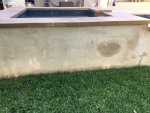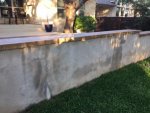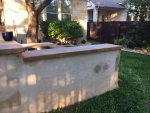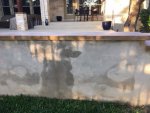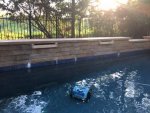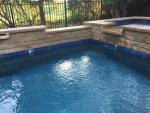Hi All,
I just found this site within the last week and am really glad as I could use some guidance. We had our new in ground pool completed in mid July 2017, and within 45 - 60 days started noticed water spots on the back of the raised wall near where our two water features are located. I immediately mentioned it to the builder and he said it was just water migration and nothing to worry about, but we would all keep an eye on it. Since that initial conversation with the builder we've seen more and more water spots, small cracks and calcium build up on the back wall. We've also seen some excessive calcium build up on the pool tile near the water features and all above the water line. In the months since September 2017 I've made numerous requests to have the builder inspect the water features to make sure they are properly sealed. He's been out to look at the issues a couple of times and continues to maintain it is just water migration which does not need repair. We also recently increase the flow of the water features and soon after saw a larger than normal water spot on the wall and some wetness on the ground. I also see a large water spot on the back wall of the spa and on the rock just above the tile on the spa that the builder has no idea where it could be coming from and has basically dismissed it also. It just seems like the issues will continue to get worse and I feel the builder is putting us off so he doesn't have to do any repairs. We have a 2 year warranty on workmanship and lifetime limited structural warranty. Please see the pictures for yourself. Am I worried about nothing or do I have an issue that needs repair? Not sure what actions to take at this time to get the builder to assist. Thanks in advance!!
I just found this site within the last week and am really glad as I could use some guidance. We had our new in ground pool completed in mid July 2017, and within 45 - 60 days started noticed water spots on the back of the raised wall near where our two water features are located. I immediately mentioned it to the builder and he said it was just water migration and nothing to worry about, but we would all keep an eye on it. Since that initial conversation with the builder we've seen more and more water spots, small cracks and calcium build up on the back wall. We've also seen some excessive calcium build up on the pool tile near the water features and all above the water line. In the months since September 2017 I've made numerous requests to have the builder inspect the water features to make sure they are properly sealed. He's been out to look at the issues a couple of times and continues to maintain it is just water migration which does not need repair. We also recently increase the flow of the water features and soon after saw a larger than normal water spot on the wall and some wetness on the ground. I also see a large water spot on the back wall of the spa and on the rock just above the tile on the spa that the builder has no idea where it could be coming from and has basically dismissed it also. It just seems like the issues will continue to get worse and I feel the builder is putting us off so he doesn't have to do any repairs. We have a 2 year warranty on workmanship and lifetime limited structural warranty. Please see the pictures for yourself. Am I worried about nothing or do I have an issue that needs repair? Not sure what actions to take at this time to get the builder to assist. Thanks in advance!!


